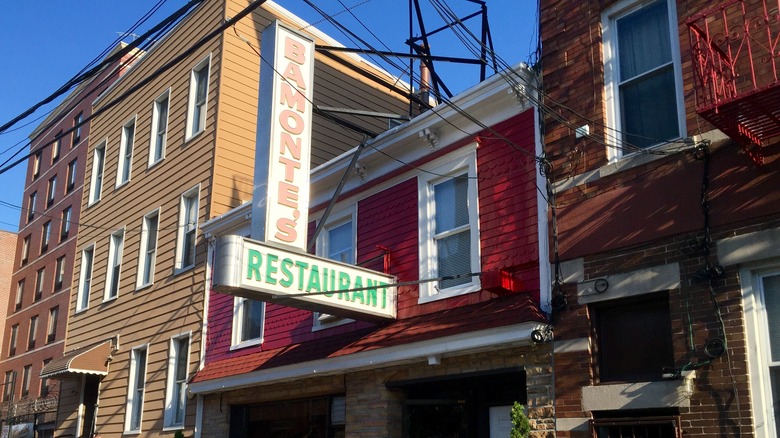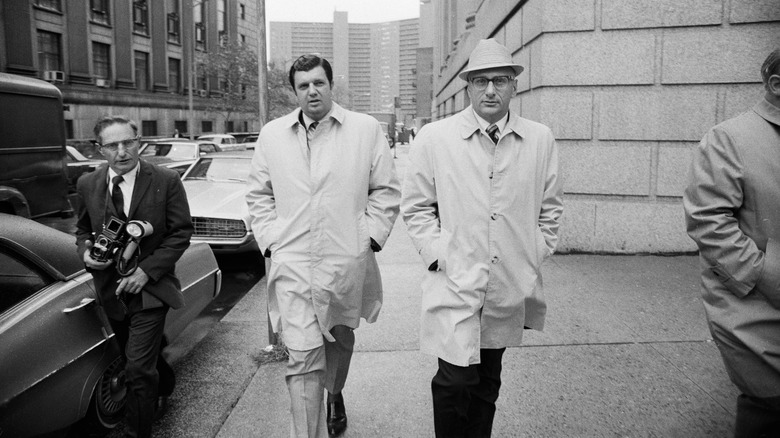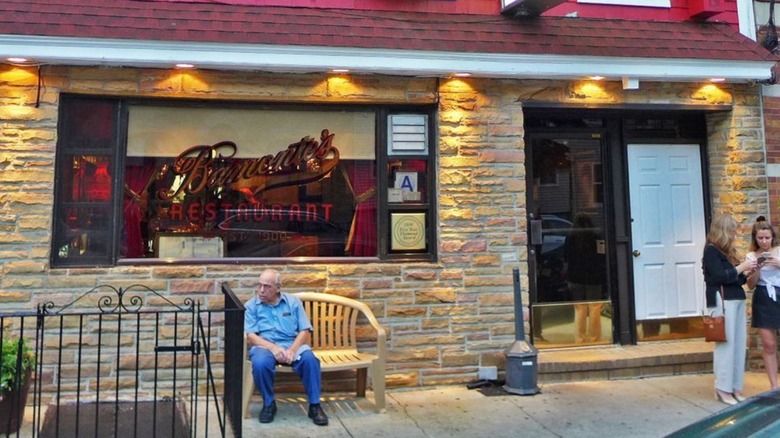Bamonte's, Brooklyn's Oldest Italian Restaurant, Has Historic Ties To The Mob
Anyone who's ever seen "Goodfellas" will surely remember the scene where the crew makes dinner in prison look like a gastronomic dream come true, slicing garlic with a razor and spending hours on a tomato sauce. In "The Godfather," the restaurant scene where Michael Corleone whacks Solozzo and Captain McCluskey was filmed at Louie's in the Bronx. The mob's connections to its favorite restaurants have been just as strong in real life as on-screen, particularly in New York City.
In 1972, Joe Gallo was killed while dining at Umberto's Clam House at the corner of Hester and Mulberry in what's now Little Italy. In 1985, Constantino Paul "Big Paulie" Castellano (boss of the Gambinos, one of the five families of NYC) was shot during a dinner at Sparks Steakhouse in midtown Manhattan. To their faithful patrons, these restaurants were a regular mainstay, but also took on another dimension of significance for their A-list clients; the joint must be trustworthy and low-key. Enter Bamonte's: the oldest Italian restaurant in Brooklyn and the former famous haunt of mob giants.
The Williamsburg joint opened in 1900 and hasn't moved locations since. Today, dinner at Bamonte's is as much a taste of Italian-American culinary prowess as a taste of NYC history. Even as trendy new brunch spots, record shops, and high-dollar vintage stores crop up in Williamsburg around it, Bamonte's remains an unshakeable New York institution.
History of Bamonte's and mob ties
When Pasquale Bamonte moved from Salerno, Italy and opened his eponymous restaurant in 1900, it first found a fanbase with Italian immigrants, who had started arriving in New York during the 1840s and then came by droves in the 1880s. Between then and 1920, tens of thousands of people had relocated from Italy to New York City.
It's uncertain exactly when or how Bamonte's became a well-known mob hangout, but it remained that way for decades, and its ties weren't a secret. In the 1950s, Bamonte's installed a glass wall between the kitchen and the dining room so diners could monitor whether their food was about to be poisoned. The interior of the restaurant was even outfitted with phone booths where folks could take private calls. Perhaps the most historic event to ever occur at the joint happened in 1979 when Carmine Galante was killed by the mob, after which the five families held a celebration at Bamonte's.
Nowadays, some foodies might argue that Williamsburg is home to better Italian restaurants — and they might have a point. But, while there's another plate of clams casino down the street, you won't be able to eat it at the same table at which infamous mobsters like Salvatore Bonnano or Tommy Gagliano might have once sat.
Experiential dining and a taste of nostalgia
Bamonte's is located in a two-story house with brick and red clapboard siding, mere feet from the Brooklyn Queens Expressway, a facade emblematic of Bamonte's unique past-meets-present brand. Bamonte's might owe its time-tested success in part to its no-frills menu. Highlights include the rigatoni with vodka sauce, zuppa di clams, pork chops with hot and sweet vinegar peppers, stuffed artichokes, mussels marinara, prosciutto with melon, handmade cheese ravioli, eggplant rollatini, and baked ziti. Dishes are served family-style (think big plates and large tables full of lots of people) with generous portion sizes, and the tuxedo-clad servers don't skimp on the wine pour, either. Bamonte's also boasts an affordable "$$" price ranking on Yelp and stocks a full bar.
Instead of mafia members, today's dinner crowd is a mixture of folks who've been coming there for ages and the artist-yuppie crowd for which Williamsburg is quickly becoming famous (or perhaps infamous). Other prominent Italian-American guests have included Frank Sinatra and Robert DeNiro. The restaurant has even served as a film set for "The Sopranos" — no surprise considering the dining room has looked the same since the 1950s (they got it right the first time). Décor includes framed pictures of the pope, heavy red curtains, crystal chandeliers, and no music; the phone booths and glass-paned kitchen remain. Curious foodies can swing by 32 Withers Street and check it out during open hours, noon till 11 p.m.


